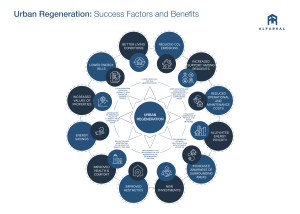The decisions we make today will shape the cities of tomorrow. In this article, we explain what urban regeneration is, why it is a significant long-term investment, and which successful cases demonstrate it.
How does urban regeneration work?
Urban regeneration is a perspective that seeks to address urban problems and improve the socioeconomic, physical, and environmental conditions of an area that has undergone changes. The process revitalizes an urban area with the aim of enhancing its quality of life and creating a more livable environment.
We must take into account that urban areas are complex and dynamic systems. They are the physical context of daily life: people live, work, and engage in all kinds of activities within them. For this reason, it is inevitable that some urban areas are subject to economic, social, and environmental problems as time passes and population density increases.
Urban problems can range from minor to major and can affect only a part of the city or the city as a whole. Urban problems encompass various combinations of environmental issues, such as abandoned land, redundant industrial buildings, pollution, and contaminated sites; social problems like poverty, lack of social cohesion, and inadequate housing; and economic problems such as a stagnant economy, high unemployment rates, and a lack of entrepreneurship. For these reasons, urban regeneration is not only a necessity to revitalize a community but also a significant investment opportunity for those involved in the projects.
Urban regeneration strategies gained momentum in the 1960s in response to the decline of post-war European cities and the rise in poverty. Initially driven by the public sector in the United Kingdom, for example, projects focused on depressed residential areas that have since been completely transformed. The Leeds and Bracknell areas serve as examples of this transformation.
In northern Spain, for instance, the principle of subsidiarity by public institutions has supported private projects that contribute to the design and implementation of urban regeneration.
Why should future cities be more sustainable?

The urban regeneration of old urban areas has become increasingly important in the evolution of the contemporary city. Increasing the energy efficiency of buildings is not only the most significant and cost-effective investment that cities can make to reduce their impact on the climate, but it is also the backbone of a prosperous society in the future.
It is essential to seek sustainable and innovative solutions to address the challenges it poses. An article published by El País in December 2022 explores some sustainable real estate solutions that can aid in urban regeneration. As the global population grows, there is a growing need for sustainable urban planning in cities and the urgency to integrate energy efficiency into existing buildings and new emerging technologies, such as the use of renewable materials, renewable energy sources, and smart technologies to monitor energy and water consumption. These disruptive solutions can play a vital role.
By choosing cost-effective and energy-efficient solutions every time we renovate, we can improve the quality of life without compromising the architectural and aesthetic qualities that make a building special.
Bilbao: An example of urban regeneration
The city of Bilbao serves as an excellent example of urban regeneration.
Bilbao is the largest city in the Basque Country in Spain, with a population of 350,000. Since the 1990s, Bilbao has undertaken a series of culture-led urban regeneration projects, becoming a global example of urban transformation by creating a museum or cultural facility in a vibrant and attractive place for residents, visitors, and internal investments.
Bilbao, as the economic center of the Basque Country, was particularly affected by industrial decline and lost centrality within the economic system. Most of the abandoned industrial sites were located along the left bank of the river, and by 1991, there were 158 abandoned sites in the city covering 450 hectares.
Since the beginning of the 21st century, Bilbao has stood out in urban regeneration projects alongside Barcelona, making it a popular destination for urban planners. The city became famous for the Bilbao Effect or Guggenheim Effect, which describes how a new cultural facility can transform a city into an appealing place for residents, visitors, and businesses.
To be more proactive in spatial planning, a new master plan for Bilbao was presented in 1989, giving significant weight to the reuse of abandoned industrial sites. Great emphasis was placed on creating widely recognizable designs, hiring internationally renowned architects. This helped Bilbao showcase a new image to the world and project its aspirations.
The case of Bilbao teaches us that urban regeneration requires not only long-term planning but also a collaborative effort between public and private institutions, emphasizing smart and visually appealing design.
Our Mission
At Alfareal, we focus on acquiring aged real estate assets that no longer meet the current market expectations and undertaking extensive remodeling, potentially involving structural or legal changes, to resell them to long-term investors as profitable investments.
We deeply believe in urban regeneration as a catalyst for change and a significant investment for our partners.
If you are interested in joining Alfareal’s urban regeneration projects, please contact us through our website.
Fuentes
- Oxford University
- Revista Internacional de Estudios Vascos
- Rockwool
- BPIE




